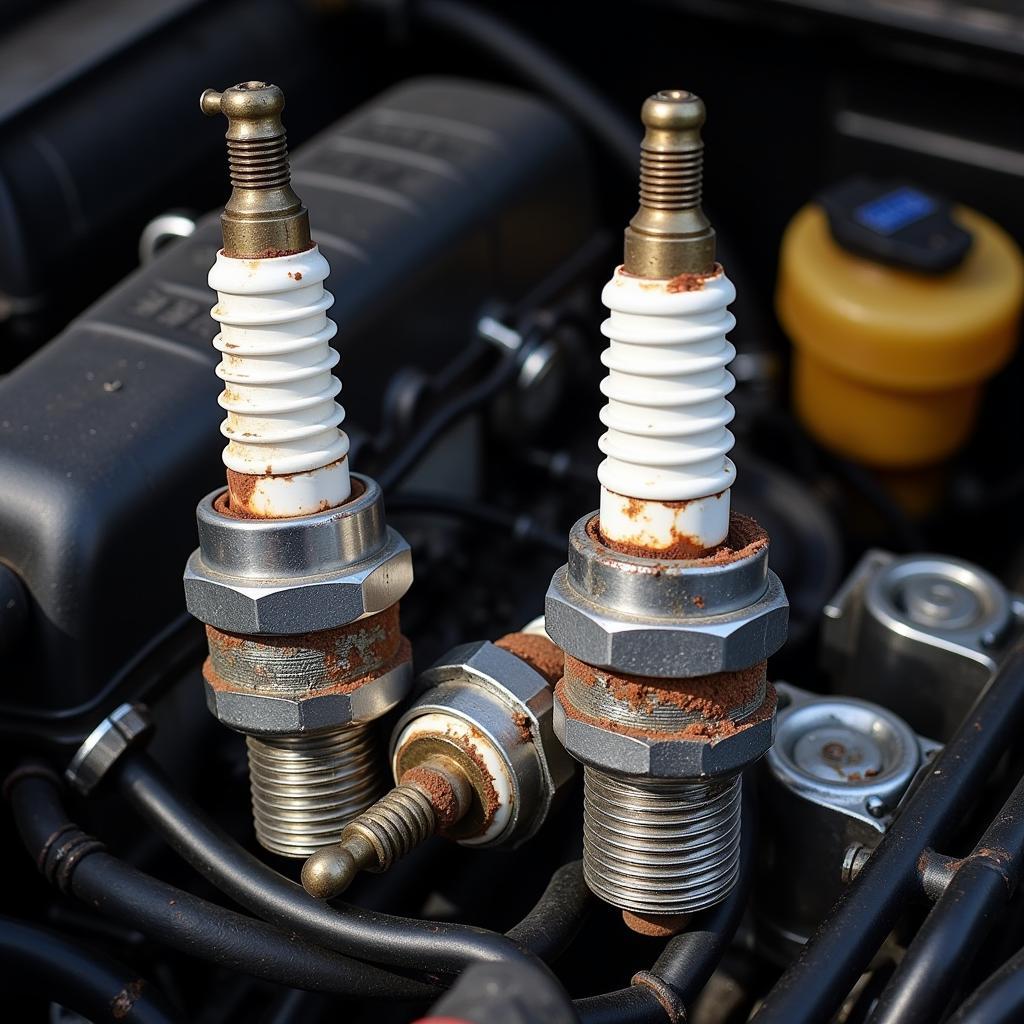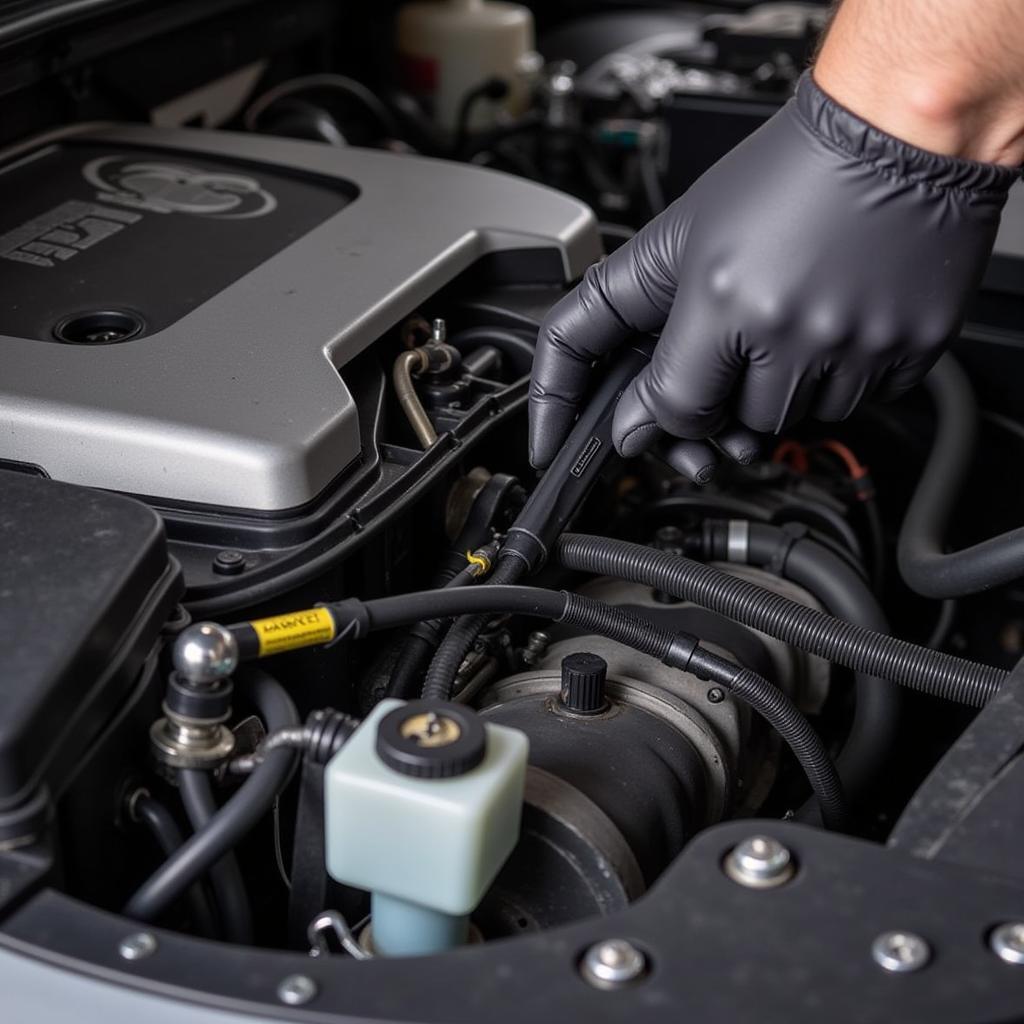A rough or unsteady idle is a common car problem that can be frustrating and concerning. This article will guide you through the common causes of a rough idle and provide practical steps on how to fix a car’s idle. From simple checks you can perform yourself to more complex issues requiring professional help, we’ll cover it all. See our guide on how to fix a cars idle for a quick overview.
Understanding Your Car’s Idle
A car’s idle is the engine speed when the vehicle is stationary and not in gear. A smooth idle is crucial for fuel efficiency, comfortable driving, and preventing potential damage to the engine. Several factors can disrupt this delicate balance, leading to a rough or unstable idle.
Common Causes of a Rough Idle
A rough idle can stem from a variety of issues, ranging from simple maintenance oversights to more complex mechanical problems. Here’s a breakdown of the most frequent culprits:
- Dirty or Faulty Spark Plugs: Worn-out spark plugs can misfire, leading to an uneven burn of fuel and a rough idle.
- Vacuum Leaks: A leak in the vacuum system can disrupt the air-fuel mixture, causing the engine to run erratically.
- Dirty or Clogged Fuel Injectors: Clogged injectors can restrict fuel flow, resulting in a lean air-fuel mixture and a rough idle.
- Faulty Idle Air Control Valve (IACV): The IACV regulates the amount of air entering the engine at idle. A malfunctioning IACV can cause the idle speed to fluctuate or stall.
- Mass Airflow Sensor (MAF) Problems: The MAF sensor measures the amount of air entering the engine. A faulty MAF sensor can send incorrect data to the engine control unit (ECU), resulting in an improper air-fuel mixture and a rough idle.
- EGR Valve Issues: A malfunctioning Exhaust Gas Recirculation (EGR) valve can cause a rough idle, especially at low speeds.
- Timing Issues: Incorrect ignition timing can lead to inefficient combustion and a rough idle. See our guide on how to fix timing issue on car for more information.
 Rough Idle Caused by Worn Spark Plugs
Rough Idle Caused by Worn Spark Plugs
Diagnosing and Fixing a Rough Idle
Diagnosing the root cause of a rough idle requires a systematic approach. Here’s a step-by-step guide:
- Check the Obvious: Begin by inspecting for loose or disconnected vacuum hoses and wiring.
- Inspect Spark Plugs: Remove and inspect the spark plugs for wear, fouling, or damage. Replace them if necessary.
- Clean or Replace Air Filter: A dirty air filter restricts airflow to the engine, potentially contributing to a rough idle.
- Check for Vacuum Leaks: Use a vacuum gauge or a can of carburetor cleaner to check for vacuum leaks.
- Clean Fuel Injectors: Use a fuel injector cleaner or have them professionally cleaned. If you think you might need a new sensor, check out our guide: do i need to fix o2 sensor in the car.
- Test IACV: Check the IACV for proper operation using a multimeter or a scan tool. Replace it if necessary.
- Test MAF Sensor: Test the MAF sensor using a multimeter or a scan tool. Replace it if faulty.
- Check EGR Valve: Inspect the EGR valve for blockage or malfunction. Clean or replace as needed.
 Mechanic Checking Vacuum Hoses
Mechanic Checking Vacuum Hoses
When to Seek Professional Help
While some rough idle issues can be resolved with DIY fixes, more complex problems require professional expertise. If you’ve tried the basic troubleshooting steps and the rough idle persists, it’s best to take your car to a qualified mechanic. You can also find helpful tips in our article about fixes for bad idling car.
“A seemingly simple rough idle can sometimes be a symptom of a more serious underlying issue. Don’t hesitate to seek professional help if the problem persists,” advises Alex Thompson, ASE Certified Master Technician.
 Diagnosing with a Scan Tool
Diagnosing with a Scan Tool
Conclusion
Fixing a car’s idle can range from a simple fix to a more complex diagnosis. By understanding the common causes and following the troubleshooting steps outlined in this article, you can often resolve the issue yourself. However, don’t hesitate to seek professional help if the problem persists or becomes more complex. Remember, a smooth idle is essential for optimal engine performance, fuel efficiency, and a comfortable driving experience. Contact AutoTipPro at +1 (641) 206-8880 or visit our office at 500 N St Mary’s St, San Antonio, TX 78205, United States for assistance with your car’s idle or any other automotive concerns.
 Smooth Running Engine
Smooth Running Engine
“Regular maintenance, such as spark plug replacements and air filter cleaning, can prevent many rough idle issues,” adds Maria Sanchez, Automotive Engineer.
FAQ
- What is the most common cause of a rough idle? Dirty spark plugs, vacuum leaks, and clogged fuel injectors are among the most common culprits.
- Can a rough idle damage my engine? A prolonged rough idle can potentially lead to further engine damage if left unaddressed.
- How often should I replace my spark plugs? Consult your car’s owner’s manual for the recommended spark plug replacement interval.
- Can I fix a vacuum leak myself? Simple vacuum leaks can sometimes be fixed by replacing the damaged hose.
- How much does it cost to fix a rough idle? The cost varies depending on the underlying cause and the necessary repairs.
- What is an IACV? The Idle Air Control Valve (IACV) regulates airflow to the engine at idle.
- What is a MAF sensor? The Mass Airflow Sensor (MAF) measures the amount of air entering the engine.




Leave a Reply